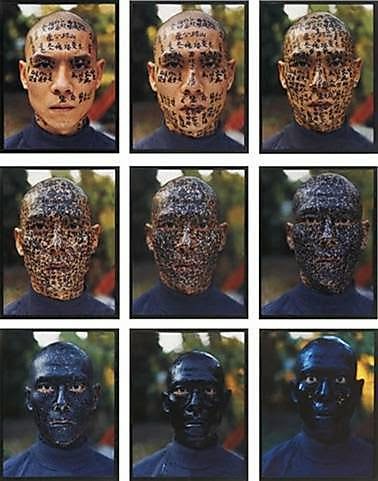The “Heartprint” of The Orphan of Zhao, How Ink Art Influenced the Production
By Shannon Stockwell
 “The centerpiece of this whole play is when Cheng Ying finally has to tell his son who he is. But it’s so painful and frightening that he can’t—so he
paints a scroll. Cheng Bo looks at his life in the scroll and discovers who he
is,” Orphan of Zhao director Carey
Perloff told the cast and design team at the first rehearsal of in May. Costume
designer Linda Cho agreed, “We talked a lot about this being a story that’s
written down. It’s a legendary story.”
“The centerpiece of this whole play is when Cheng Ying finally has to tell his son who he is. But it’s so painful and frightening that he can’t—so he
paints a scroll. Cheng Bo looks at his life in the scroll and discovers who he
is,” Orphan of Zhao director Carey
Perloff told the cast and design team at the first rehearsal of in May. Costume
designer Linda Cho agreed, “We talked a lot about this being a story that’s
written down. It’s a legendary story.”
The crucial role that writing and painting play in The Orphan of Zhao led Perloff to an exhibit at New York’s
Metropolitan Museum of Art called Ink Art: Past as Present in Contemporary China.
The exhibit, which opened in December 2013 and closed April 2014, was the first
major exhibition of Chinese contemporary art at the Met, and featured about 70
works by 35 artists.
Every piece of artwork was inspired by ink, which has been the principal medium
in Chinese art for over two millennia.>
 “It’s among the most amazing contemporary work I’d ever seen,” said
Perloff of the exhibit. “It plays with this notion of inscription: What are our
stories? How do we tell our stories? What is the relationship of physical
character to those stories?” The influence of the ubiquitous nature of ink in
Chinese art is apparent in Cho’s costume design; for example, the basic unisex
costume all cast members wear is a painted tunic that looks as though it has
been dipped in ink:
“It’s among the most amazing contemporary work I’d ever seen,” said
Perloff of the exhibit. “It plays with this notion of inscription: What are our
stories? How do we tell our stories? What is the relationship of physical
character to those stories?” The influence of the ubiquitous nature of ink in
Chinese art is apparent in Cho’s costume design; for example, the basic unisex
costume all cast members wear is a painted tunic that looks as though it has
been dipped in ink: More specifically, Cho was inspired by the piece Book from the Sky,
which was first mounted in China in 1988 and has traveled the world since. The
piece, created by Xu Bing, features several large scrolls covered in what
appears to be Chinese calligraphy. However, upon closer inspection, the viewer learns
that none of the characters are actual Chinese letters, and the scrolls are gibberish.
According to curator Maxwell K. Hearn, Book
from the Sky is a response to “the often blatant contradiction between
propaganda and reality, words and actions, in a China where doctrine, news, and
history were continually being rewritten and texts could no longer be
trusted”—an analysis that also seems to fit The
Orphan of Zhao.
More specifically, Cho was inspired by the piece Book from the Sky,
which was first mounted in China in 1988 and has traveled the world since. The
piece, created by Xu Bing, features several large scrolls covered in what
appears to be Chinese calligraphy. However, upon closer inspection, the viewer learns
that none of the characters are actual Chinese letters, and the scrolls are gibberish.
According to curator Maxwell K. Hearn, Book
from the Sky is a response to “the often blatant contradiction between
propaganda and reality, words and actions, in a China where doctrine, news, and
history were continually being rewritten and texts could no longer be
trusted”—an analysis that also seems to fit The
Orphan of Zhao. Cho applied a similar style of abstracted writing to the costume of the
Ballad Singer, whose beautiful poetic songs frame the show and summarize the
tale the audience is about to witness. Cho was attracted to idea of a costume
covered with unintelligible writing because it “steps away from being a historical
reproduction of anything.” This aesthetic influenced her costume design, which she
describes as “abstracted historical Chinese.”
Cho applied a similar style of abstracted writing to the costume of the
Ballad Singer, whose beautiful poetic songs frame the show and summarize the
tale the audience is about to witness. Cho was attracted to idea of a costume
covered with unintelligible writing because it “steps away from being a historical
reproduction of anything.” This aesthetic influenced her costume design, which she
describes as “abstracted historical Chinese.”
Just as Perloff and Cho found calligraphy to be central to the story of
The Orphan of Zhao, Hearn believes
that it is “China’s highest form of artistic expression as well as its most
fundamental means of communication.” Not only do the words themselves convey
meaning, but the way an artist forms
a character is significant. A practitioner might draw upon the work of artists
before him or her, and, according to Hearn, “every trace of the brush carries
the autographic handprint or ‘heartprint’ of the individual, reflective of his
or her intellect, emotions, and connection with the past. Thus have Chinese
cultural traditions been sustained and renewed.”
Read more about A.C.T.'s production of The Orphan of Zhao in
Words on Plays! Click here to purchase a copy.

